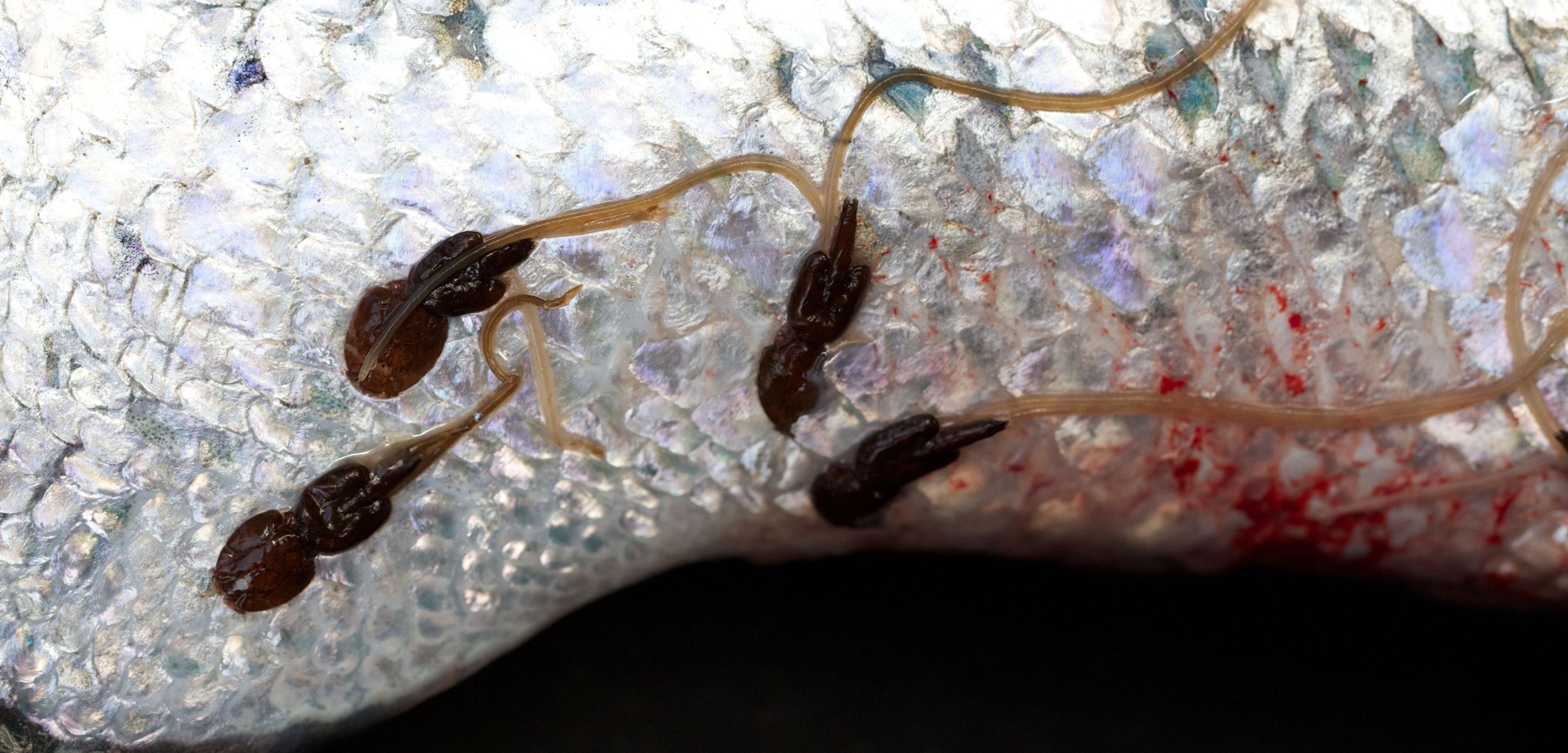Fish Farms Can Be Disease Accelerators
Much like terrestrial animal farms, fish farms are incubators for disease.
Article body copy
Last summer, more than half a million farmed salmon died from a sea lice outbreak in New Brunswick’s Passamaquoddy Bay. More than 250,000 died directly from the parasites, which attach themselves to the fish and feed on their skin, blood, and mucus, while another 284,000 were euthanized to try to contain the spread.
The outbreak, which affected two sites owned by Gray Group, a bankrupt aquaculture company that still had fish in its pens, was a “catastrophic loss,” says Matthew Abbott, an environmentalist who monitors Passamaquoddy Bay for the Conservation Council of New Brunswick. “Both sites were wiped out.”
But, Abbott adds, it did not come as a surprise—sea lice outbreaks are common on East Coast salmon farms, and even healthy farms have lice numbers far higher than those on the Pacific Coast. “This was just a slightly more dramatic example of the norm,” he says, a sign that without careful management, disastrous parasite outbreaks can quickly wipe out stocks.
Salmon naturally have a wide diversity of parasites, such as lice, viruses, and bacteria, says Martin Krkošek, who studies aquaculture at the University of Toronto. A diverse parasite community is actually a sign of a healthy ecosystem. But these parasites are shared between wild and farmed populations, and that’s where the trouble starts.
“The main issue is the way we raise farmed salmon in net pens in coastal areas,” says Krkošek. “Not surprisingly, it’s also a good habitat for wild salmon.”
When diseases and parasites from wild populations get into the farmed ones, they can run riot. The high density and low genetic diversity of the farmed fish, and the fact that they stay put in the net pens, makes it easy for parasites to quickly spread through the population.
“These are good conditions for parasites,” says Krkošek. And having so many hosts so close together also “short-circuits the transmission cycle,” he says, making it easier for parasites to jump from adult to juvenile fish. The result is that parasites are adapting to become more virulent—spreading faster and killing their hosts more quickly.
And much as antibiotic resistant diseases are cropping up in animal farms, attempts by fish farmers to fight the parasites and disease have also led to the development of resistance to common drugs and pesticides. “On the East Coast, lice have evolved resistance to most drugs,” says Krkošek. “And the industry in Europe is really struggling, too.”
Sea lice and infectious salmon anaemia (ISA) are the most common and most dangerous infections in salmon aquaculture, but Krkošek cautions there is a much broader range of parasites and diseases out there that we know almost nothing about. “We don’t know how they’re transmitted, or how they’re evolving,” he says.
One such disease is heart and skeletal muscle inflammation (HSMI), which affects a fish’s ability to swim and feed. Since it was discovered in 1999, HSMI has grown to become the third-largest problem for salmon aquaculture in Norway after lice and ISA, affecting hundreds of farms, according to Kristi Miller-Saunders, a molecular biologist with Fisheries and Oceans Canada. The cause of HSMI is still unknown. Researchers suspect that the disease is linked to a virus, Piscine orthoreovirus—the disease has never shown up without the virus being present first—but they have not yet been able to prove a causal link, or develop an effective vaccine.
The disease is spreading, though. In a new paper, Miller-Saunders and her colleagues recently reported on the first confirmed case of HSMI on a British Columbia salmon farm.
HSMI is not a huge problem even if fish are affected, she says. While the virus is relatively common, the disease doesn’t develop all that often. When it does, the mortality rate is less than 20 percent, and the fish are still safe to eat once they recover. “The fish can tolerate it,” she says. “Just like how most humans won’t die of the flu.”
But HSMI does hang around for a long time. Miller-Saunders found that HSMI was present on the salmon farm for 11 months, and at its peak 90 percent of the fish showed signs of the disease. This means the fish were shedding the virus into the environment that whole time, offering plenty of opportunities to infect wild fish. So far, while wild fish do appear to be susceptible to the virus associated with HSMI, there hasn’t been any sign of the disease in wild populations.
But if it becomes established, a chronic, low-level disease like HSMI could be a bigger problem for wild populations than an acute disease that has evolved high virulence in densely packed domestic fish. While a highly virulent strain can easily kill a fish, such an aggressive disease will quickly burn itself out in the low density of a wild population before it can do a great deal of harm. “With wild fish, we’re more interested in chronic diseases,” says Miller-Saunders. “Ones that could be able to move through wild populations.”
Miller-Saunders now wants to study whether there is some environmental stressor that might trigger the disease to flare up.
Although they’re a headache for fish famers, the movement of parasites and diseases between wild and domestic fish could have a positive effect. Krkošek says that this sort of exchange could actually help keep diseases under control. As wild fish migrate past fish farms, they can spread less-virulent and non-resistant strains of parasites to the captive populations, slowing the development of more virulent strains of diseases. This is one possible reason why many parasites are a bigger problem on the East Coast, where wild stocks of Atlantic salmon are low, than on the West Coast, where wild salmon are still plentiful.
“The aquaculture industry mostly sees wild fish as a nuisance, but the twist is that a moderate input of disease could help keep virulence down,” he says.

